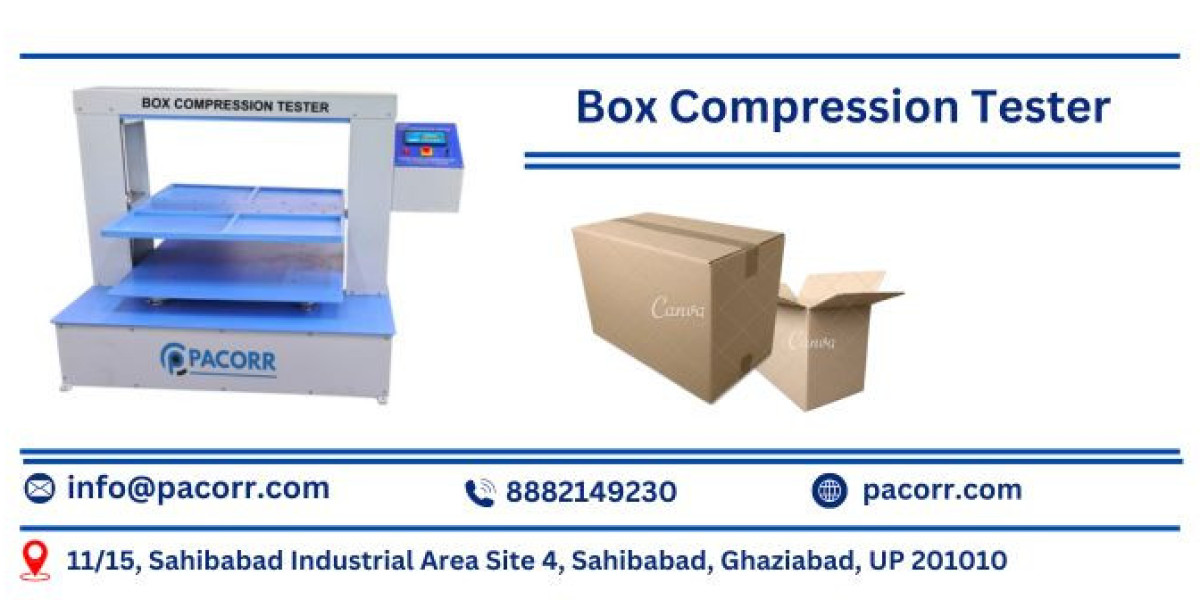What is a Box Compression Tester?
A Box Compression Tester is a specialized machine used to measure the compressive strength of boxes and other packaging materials. It applies a compressive load to the box until it deforms or fails, providing valuable data about its load-bearing capacity. This information is critical for manufacturers to ensure their packaging can protect products during shipping and storage.
Key Features of the Box Compression Tester
Robust Construction: The Box Compression Testing is built with a sturdy frame to handle high compressive loads and ensure accurate results.
· Precision Load Cells: These are used to measure the applied force with high accuracy, ensuring reliable and repeatable test results.
· User-Friendly Interface: Modern testers come with digital displays and easy-to-use controls, allowing operators to set test parameters and view results effortlessly.
· Adjustable Test Settings: Users can customize the test settings to simulate different conditions, such as varying load speeds and holding times.
Benefits of Using a Box Compression Tester
1. Enhanced Product Protection: By determining the compressive strength of packaging, manufacturers can design stronger boxes that better protect products during transit.
2. Cost Savings: Understanding the limits of your packaging can prevent over-engineering, leading to material savings and cost reductions.
3. Compliance with Standards: Many industries have strict packaging standards. Using a Box Compression Tester Price helps ensure your packaging meets these regulatory requirements.
4. Improved Customer Satisfaction: Stronger packaging reduces the risk of product damage, leading to higher customer satisfaction and fewer returns.
Applications of the Box Compression Tester
· Corrugated Boxes: Commonly used for shipping, these boxes need to be strong enough to withstand stacking and handling pressures.
· Folding Cartons: Used in various industries, including food and beverage, these cartons require testing to ensure they maintain their shape and integrity.
· Plastic Containers: Some packaging materials, such as plastic containers, also benefit from compression testing to ensure they can support the weight of stacked products.
How to Use a Box Compression Tester
1. Prepare the Sample: Place the box or container on the testing platform, ensuring it is cantered and properly aligned.
2. Set Test Parameters: Enter the desired test settings, such as load speed and maximum load, using the tester’s control panel.
3. Conduct the Test: Start the test, and the machine will apply a compressive load to the sample. Monitor the test progress on the digital display.
4. Analyze Results: Once the test is complete, review the results to determine the compressive strength of the sample. Use this data to make informed decisions about packaging design and materials.
Conclusion
The Box Strength Tester is an indispensable tool for any manufacturer concerned with the durability and reliability of their packaging. By providing precise measurements of compressive strength, it helps ensure that products are well-protected during shipping and storage, ultimately leading to higher customer satisfaction and lower costs. For more information about the Box Compression Tester and other quality testing equipment, visit Pacorr Testing Instruments.
FAQ: Box Compression Tester
Q1: What is the primary function of a Box Compression Tester?
A1: The primary function of a Box Compression Tester is to measure the compressive strength of boxes and other packaging materials to ensure they can withstand the stresses of transportation and storage.
Q2: Why is compressive strength important for packaging?
A2: Compressive strength is important because it indicates how much load a box can handle before deforming or failing. This ensures that the packaging can protect the contents effectively.
Q3: Can the Box Compression Tester be used for materials other than corrugated boxes?
A3: Yes, the Box Compression Tester can be used for various packaging materials, including folding cartons and plastic containers, to test their load-bearing capacity.
Q4: What are some common test parameters that can be set on a Box Compression Tester?
A4: Common test parameters include load speed, maximum load, and holding time. These settings can be adjusted to simulate different conditions and requirements.
Q5: How does using a Box Compression Tester lead to cost savings?
A5: By understanding the compressive strength of your packaging, you can avoid over-engineering, which reduces material usage and associated costs while still ensuring adequate protection.
Q6: Are there industry standards that require the use of a Box Compression Tester?
A6: Yes, many industries have strict packaging standards that require Box Compression Testing for compressive strength to ensure compliance and protect the integrity of shipped products.
Q7: What kind of data does a Box Compression Tester provide?
A7: The tester provides data on the maximum compressive load the packaging can withstand before failure, which helps in making informed decisions about packaging design and materials.
For more detailed information and to explore our range of testing equipment, visit Pacorr Testing Instruments.








